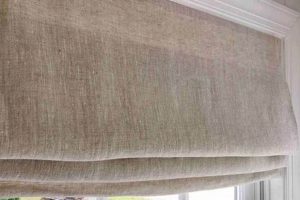A do-it-yourself cinematic display involves constructing a projection surface for viewing films or other visual media. For instance, individuals might utilize materials like stretched fabric or painted plywood to create a large-format display within their homes or other spaces.
The practice of building a personal viewing screen offers several advantages, including cost savings compared to purchasing pre-made screens and the ability to customize the size and aspect ratio to fit specific room dimensions. Historically, the desire for accessible and personalized entertainment solutions has driven innovation in this area, allowing individuals to replicate a theatrical experience in a controlled environment.
Further discussion will focus on materials selection, construction techniques, and optimization strategies for achieving a high-quality viewing experience using a self-assembled projection screen.
DIY Cinema Screen
The following section outlines actionable strategies to optimize the creation and performance of a self-constructed projection surface. Careful consideration of these points will contribute to an enhanced cinematic experience.
Tip 1: Fabric Selection. Employ a matte white fabric with a high gain factor for optimal brightness and color accuracy. Avoid textured materials that may introduce visual artifacts. Muslin or blackout cloth are frequently used, though their properties require careful evaluation for specific viewing conditions.
Tip 2: Frame Rigidity. Construct a robust frame using wood or metal. Ensure that the frame is perfectly square and resistant to warping, which can distort the projected image. Cross-bracing is recommended for larger screens to maintain structural integrity.
Tip 3: Tensioning Mechanism. Implement a reliable tensioning system to eliminate wrinkles and sagging in the fabric. Springs, turnbuckles, or stapling can be used, depending on the frame design. Consistent and even tension is crucial for a smooth viewing surface.
Tip 4: Surface Preparation. If painting a rigid surface, apply multiple thin coats of a matte white or gray screen paint using a high-density foam roller. Sand lightly between coats to achieve a perfectly smooth and uniform finish. Proper surface preparation minimizes imperfections that may be visible during projection.
Tip 5: Ambient Light Control. Minimize ambient light in the viewing environment. Darkened rooms significantly improve contrast and color saturation. Blackout curtains, dark wall colors, and strategically placed lighting fixtures contribute to a more immersive viewing experience.
Tip 6: Projector Alignment. Precisely align the projector with the center of the screen to minimize keystone distortion. Use the projector’s built-in keystone correction features sparingly, as they can reduce image quality. Proper projector placement ensures optimal geometry and sharpness.
Tip 7: Screen Size Optimization. Determine the optimal screen size based on the viewing distance and projector’s throw ratio. Larger screens provide a more immersive experience, but may require a brighter projector and a wider viewing angle. Calculate the appropriate size to balance image quality and viewing comfort.
Adherence to these recommendations facilitates the creation of a high-quality projection surface, yielding improved image fidelity and a more engaging cinematic experience.
The subsequent section will address potential challenges encountered during the construction process and propose solutions for mitigating common issues.
1. Screen Material Selection
Screen material selection represents a crucial determinant in the final performance of any do-it-yourself cinematic display. The chosen material directly impacts image brightness, contrast, color accuracy, and overall viewing experience. Suboptimal material selection can negate other careful construction efforts.
- Gain Factor and Brightness
The gain factor quantifies the material’s ability to reflect light. A high gain material concentrates reflected light, resulting in a brighter image but potentially narrower viewing angles. Conversely, a low gain material disperses light more evenly, offering wider viewing angles but potentially requiring a brighter projector. For example, a material with a gain of 1.0 reflects light evenly, while a material with a gain of 2.0 reflects twice as much light within a narrower cone. Selection depends on projector brightness and intended viewing arrangement within the space.
- Surface Texture and Image Clarity
The surface texture of the screen material can significantly affect image clarity. Highly textured surfaces, such as linen or burlap, may introduce visual artifacts and reduce sharpness. Smooth surfaces, such as matte white fabric or specialized screen paints, minimize these distortions and provide a clearer image. For example, projecting onto a heavily textured wall will result in a less sharp image than projecting onto a smooth, painted screen. The selection of smooth material is essential for achieving high fidelity image reproduction.
- Color Neutrality and Accuracy
The color neutrality of the screen material dictates the accuracy of color reproduction. Materials with a slight tint can skew colors, affecting the intended viewing experience. Matte white and light gray materials are often preferred due to their relatively neutral color profiles. For example, projecting onto a blue-tinted wall will result in a color-cast image, compromising the accuracy of the displayed content. Calibration can somewhat mitigate this, but a neutral starting point is preferable.
- Durability and Maintenance
The durability and ease of maintenance of the screen material are practical considerations. Some materials are more prone to tearing, staining, or creasing. Selecting a durable and easily cleanable material prolongs the lifespan of the display and reduces the need for frequent replacement. For instance, PVC-backed vinyl screens are more resistant to tearing and can be easily cleaned with a damp cloth, while delicate fabrics may require more careful handling.
Careful consideration of these factors ensures that the chosen screen material complements the projector’s capabilities and the viewing environment, ultimately contributing to a more immersive and enjoyable cinematic experience when constructing a do-it-yourself projection surface.
2. Frame Construction Rigidity
Frame construction rigidity is a foundational element for a self-made cinematic display, influencing both the visual quality of the projected image and the longevity of the structure. A stable, unyielding frame is critical for maintaining a flat, uniform projection surface, ensuring an optimal viewing experience.
Dimensional Stability and Image Distortion Dimensional stability of the frame is paramount to preventing image distortion. A frame that warps or flexes under tension will compromise the flatness of the screen material, leading to visible undulations and uneven focus across the projected image. For instance, a wooden frame constructed from improperly seasoned lumber is susceptible to warping over time, creating a permanently distorted viewing surface. Precise and stable construction mitigates these issues.
- Material Selection and Structural Integrity
The selection of materials directly impacts the structural integrity of the frame. Materials such as steel or high-density hardwoods offer superior rigidity compared to softwood or lightweight plastics. Employing appropriate joining techniques, such as welding or robust bolting, further enhances structural integrity. A frame built with inadequate materials and joining methods will be prone to sagging or failure, rendering the screen unusable. The frame must be strong enough to withstand the tension of the screen material and external forces.
- Tension Distribution and Surface Uniformity
A rigid frame facilitates even tension distribution across the screen material. Uneven tension can cause wrinkles, creases, and stretching, all of which degrade image quality. A frame that can withstand high levels of tension without deformation allows for a uniformly taut surface, essential for optimal image projection. For example, a poorly constructed frame may exhibit localized areas of high tension, leading to premature wear and tear on the screen material.
- Long-Term Durability and Screen Longevity
The rigidity of the frame directly contributes to the long-term durability of the overall screen assembly. A well-constructed and rigid frame provides a stable platform that protects the screen material from stress and damage. This extends the lifespan of the screen and reduces the need for frequent repairs or replacements. A flimsy frame is vulnerable to damage from minor impacts or environmental factors, ultimately shortening the usable life of the DIY cinema screen.
In summary, frame construction rigidity is an indispensable factor in the successful creation of a do-it-yourself cinematic display. Proper material selection, sound construction techniques, and a focus on dimensional stability are essential for achieving a high-quality, long-lasting projection surface that delivers an optimal viewing experience. The frame acts as the foundation upon which the entire screen’s performance rests.
3. Fabric Tension Uniformity
Fabric tension uniformity represents a critical factor in achieving optimal image quality on a do-it-yourself cinema screen. Uneven tension directly affects the projected image, causing distortions that detract from the viewing experience. Regions of high tension may exhibit stretching or puckering, while areas of low tension can sag or wrinkle. These imperfections alter the projected light path, resulting in inconsistent brightness, blurred details, and inaccurate color representation across the screen surface.
The construction of a diy cinema screen necessitates a methodical approach to tensioning the fabric. This process involves ensuring equal force distribution across the entire screen surface. One common method involves using a frame with strategically placed springs or turnbuckles to apply consistent tension. Another approach entails meticulously stapling the fabric to the frame, ensuring each staple exerts equal force. Failure to maintain uniform tension manifests as visible imperfections during projection, such as keystoning, uneven brightness, and localized blurring. For example, a screen with loose fabric in one corner will project a distorted image, requiring constant refocusing and compromising the overall viewing experience. Proper tensioning, conversely, provides a smooth, consistent surface for accurate image reproduction.
Achieving fabric tension uniformity presents several practical challenges. Fabric type, frame design, and environmental conditions all influence the final result. Certain fabrics exhibit greater elasticity than others, requiring careful adjustment during tensioning. Fluctuations in temperature and humidity can also affect fabric tension, necessitating periodic adjustments to maintain optimal performance. Despite these challenges, the benefits of fabric tension uniformity in a diy cinema screen are undeniable. A well-tensioned screen provides a visually immersive and enjoyable viewing experience, closely approximating the quality of commercially manufactured screens. Therefore, meticulous attention to fabric tensioning is essential for achieving the desired cinematic experience within a self-built setting.
4. Ambient Light Mitigation
Ambient light significantly degrades the visual performance of a do-it-yourself cinema screen. The unwanted illumination reduces contrast, washes out colors, and diminishes the overall clarity of the projected image. Constructing a projection screen involves careful consideration of the cause-and-effect relationship between ambient light levels and perceived image quality. Reduced contrast occurs as ambient light raises the black level of the projected image, minimizing the difference between the brightest and darkest points. Diminished color saturation results from ambient light diluting the purity of projected colors. A dimly lit room, by contrast, allows the projector’s light to dominate, maximizing contrast and color vibrancy. Ambient light mitigation is therefore not merely a peripheral consideration, but a critical component in achieving a satisfactory cinematic experience.
Practical examples highlight the importance of ambient light control. Projecting an image on a screen in a sunlit room yields a washed-out, barely visible image. However, the same projection in a darkened room produces a vibrant, high-contrast image. This necessitates strategic efforts to minimize external light sources. Blackout curtains, strategically placed light-absorbing materials, and room layout designed to minimize light intrusion all contribute to effective ambient light mitigation. In situations where complete darkness is unachievable, using a screen material with a higher gain factor can partially compensate for ambient light, although this often results in a narrower viewing angle. The practical application of ambient light mitigation principles demonstrably elevates the perceived image quality and immersiveness of a self-made projection system.
In conclusion, ambient light mitigation is indispensable for realizing the full potential of a do-it-yourself cinema screen. Understanding the detrimental effects of ambient light, coupled with implementing appropriate mitigation strategies, is crucial for achieving a satisfying viewing experience. While challenges may arise in controlling ambient light in all environments, the significant improvements in image quality achieved through such efforts underscore the value of this consideration. The absence of such mitigation renders even the most meticulously constructed screen significantly less effective.
5. Projector Alignment Precision
Projector alignment precision is a critical determinant of visual quality in a do-it-yourself cinematic display. Deviation from optimal alignment introduces geometric distortions, focus inconsistencies, and brightness irregularities, significantly impacting the viewing experience. Careful attention to this factor is essential for maximizing the potential of any self-constructed projection surface.
- Keystone Correction and Geometric Accuracy
Keystone distortion, a trapezoidal deformation of the projected image, arises from non-perpendicular projection angles. While digital keystone correction features offer a software-based solution, they inherently reduce image resolution and introduce artifacts. Precise physical alignment minimizes the reliance on these corrections, preserving the integrity of the projected image. For instance, projecting onto a diy cinema screen from a severely angled position necessitates aggressive keystone correction, resulting in a noticeably softer image than achieved with proper alignment. Proper projector placement is paramount.
- Focus Consistency Across the Screen
Optimal focus is contingent on maintaining a consistent projection distance across the entire screen surface. Misalignment results in differential focus, where portions of the image appear sharp while others are blurred. This is particularly noticeable with larger diy cinema screens. For example, an improperly aligned projector may exhibit sharp focus at the center of the screen but pronounced blurring along the edges. Accurate alignment ensures that the projected light rays converge uniformly across the screen surface, creating a consistently sharp image.
- Brightness Uniformity and Image Evenness
Uneven brightness distribution across the screen can result from off-axis projection. Light intensity typically decreases as the angle of incidence increases. Misalignment exaggerates this effect, leading to a brighter center and dimmer edges or corners. For example, if the projector is significantly off-center, the corner of the diy cinema screen furthest from the projector will appear noticeably darker than the opposite corner. Precise alignment ensures that the light is distributed more evenly, resulting in a more balanced and visually pleasing image.
- Minimizing Optical Distortion and Enhancing Clarity
Lens distortion, inherent in projector optics, is exacerbated by misalignment. Precise alignment ensures that the projected light passes through the lens in the manner intended by the manufacturer, reducing aberrations and maintaining optimal image clarity. By correctly positioning the projector, it becomes easier to adjust and fine-tune for the best possible focus and reduce any visual errors. By carefully aligning and correcting any lens distortion, the diy cinema screen becomes far more effective in its visual display.
The facets of projector alignmentkeystone correction, focus consistency, brightness uniformity, and the mitigation of optical distortioncollectively underscore its importance in the creation of a high-quality diy cinema screen. Meticulous attention to alignment yields a demonstrably superior viewing experience, justifying the effort invested in this crucial aspect of screen construction and projector setup.
diy cinema screen
The following section addresses frequently asked questions regarding the construction and optimization of do-it-yourself cinematic displays.
Question 1: What is the minimum acceptable gain factor for a diy cinema screen intended for use in a room with uncontrolled ambient light?
A minimum gain factor of 1.2 is generally recommended for screens used in environments with moderate ambient light. Higher gain materials can improve brightness, but may narrow the viewing angle and introduce hotspots.
Question 2: What type of adhesive is most suitable for attaching screen fabric to a wooden frame without causing damage or discoloration?
A low-VOC, acid-free spray adhesive is recommended. These adhesives minimize the risk of fabric discoloration and provide a secure bond without damaging the material.
Question 3: Is it necessary to use a dedicated screen paint for rigid diy cinema screens, or can standard interior paint be substituted?
While standard interior paint can be used, dedicated screen paints are formulated to provide optimal reflectivity, color neutrality, and surface smoothness, resulting in a superior image compared to conventional paints.
Question 4: What is the recommended frame material for a large-format diy cinema screen exceeding 120 inches in diagonal?
For screens of this size, a steel frame is recommended due to its superior rigidity and resistance to warping. Wood frames may be used, but require substantial bracing to maintain dimensional stability.
Question 5: What steps can be taken to minimize the visibility of seams in diy cinema screens constructed from multiple pieces of fabric?
Overlap the fabric edges by a small margin (approximately 1/4 inch) and use a specialized seam roller to create a smooth, nearly invisible joint. Applying a thin bead of flexible adhesive along the seam can further enhance its integrity.
Question 6: How can moir patterns be avoided when using a projector with a pixel structure that interacts with the screen fabric’s weave?
Selecting a screen fabric with a very fine weave or a random pattern can minimize the risk of moir. Increasing the viewing distance or slightly defocusing the projector can also reduce the visibility of these patterns.
These questions highlight key considerations in diy cinema screen construction, emphasizing the importance of material selection, assembly techniques, and environmental factors.
The subsequent section provides a comprehensive guide to troubleshooting common issues encountered during the construction and use of a diy cinema screen.
Conclusion
This exploration of the diy cinema screen concept has underscored the multifaceted considerations inherent in its successful implementation. From the selection of appropriate screen materials to the precision required in projector alignment, each element plays a critical role in the ultimate viewing experience. Achieving optimal performance necessitates a thorough understanding of the interplay between ambient lighting, fabric tension, and frame stability. The preceding discussion has illuminated both the benefits and the potential pitfalls associated with this endeavor.
The construction of a diy cinema screen represents a commitment to personalized cinematic immersion. By carefully applying the principles outlined herein, individuals can create a viewing environment tailored to their specific needs and preferences. Continued innovation in materials and techniques promises to further enhance the accessibility and quality of self-made projection systems, solidifying their place as a viable alternative to commercially manufactured screens. The pursuit of optimal visual fidelity remains the driving force behind these ongoing advancements.







